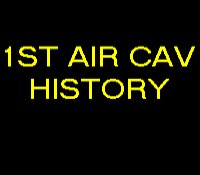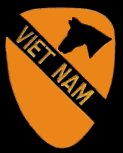5-10-2023

This information below was sent to me by " Mr. Michael O'Neil " (PILOT) - D/229th Avn Bn - "Cobra10".
He writes: I found the information informative and it helped bring back memories of the camaraderie and "esprit de corps" of the 229th AHB and all of the 1st Air Cav.

(Airmobile)
Arrived Vietnam 11 September 1965 from Fort Benning
Departed Vietnam 29 April 1971 to Fort Hood
Division and Task Force OREGON
Commanders
Major General John Norton---May '66
Major General John J.Tolson III---April '67
Major General George I. Forsythe---July '68
Major General Elvy B. Roberts---May '69
* Major General George W. Casey---May '70
Brigadier General Jonathan R. Burton (acting)---July '70
Major General George W. Putnam Jr.---July '70
* Killed in helicopter crash----7 July '70
The 1st Air Cavalry Division ("The First Team") was activated 13 September
1921 at Fort Bliss and dismounted in 1943 prior to being sent overseas 23 May
1943 to the Pacific in World War II. It fought first in the Admiralty
Islands in Fedruary 1944 and landed at Leyte in the Philippines 20 October 1944
and becoame the first to enter Manila, sending another flying column 100 miles
inland to liberate allied prisoners. It left Luzon for occupation duty in Japan
and was the first U.S. divison into Tokyo, arriving there 8 September 1945. The
division remained there unti rushed into Korea, where it carreid out the first
amphibious invasion at Pohangdong and was the first U.S. division to enter the
North Korean capital of Pyongyang. In December 1951 it was moved back to Japan
(service in Korea was 18 July 1950-22 December 1951). In 1957 it redeployed to
Korea. At Fort Benning the 11th Air Assault Division (test) was raised and
thoroughly tested in the airmobile tactics during 1964. In June 1965 the colors
of the 1st Cavalry Division were flown to Fort Benning and the 11th Air Assault
Division's assets transferred to the 1st Cavalry Division, which was then sent to
Vietnam as the first full division of the U.S. Army to arrive. During
October-November 1965 the 1st Cavalry Division fought the enemy to a standstill
in the bitter battle of Ia Drang Valley in Pleiku Province, winning a
Presidential Unit Citation. For the next 13 months members of "The First Team"
met and defeated strong enemy forces throughout the II Corps Tactical Zone.
In the spring of 1966, the 1st Cavalry Division fought to clear Binh Dinh
Province in a series of operations known as MASHER/WHITE WING/THANG PHONG II
which became the first large unit operations across corps boundaries when the
U.S. Marines crossed into Binh Dinh to link up with the 1st Cavalry Divison. In
August 1966 the divison went into Pleiku Province in Operation PAUL REVERE II.
Battion-sized elements of the divisons's Skytroopers were also battling in Binh
Thuan Province from August 1966 though January 1968. In October 1966 the division
teamed up with the Repubic of Korea and South Vietnamese forces in Binh Dinh
Province in Operation IRVING. From the end of October into February of 1967 the
1st Cavalry Division continued to clear Binh Dinh Province in Operation THAYER
II, which was in turn followed by Operation PERSHING in the rich northern
coastal plain as well as the Kim Son and Luoi Ci Valleys to the west.
Throughtout the remainder of 1967 the division combated the North Vietnamese
Army's 610th Division and the Viet Cong units in the II Corps Tactical Zone. In
January 1968 the divison was ordered to I Corps Tactical Zone, arriving in time
to blunt the enemy's Tet offensive. Elements in II Corps continued the fight for
Binh Dinh Province in Operation PERSHING II in February 1968, but because of
events the larger part of the divison was committed to the contest near Hue.
Then the 1st Cavalry Division moved swiftly to relieve the embattled U.S. Marine
base at Khe Sanh in April 1968, along with other U.S. Marine and South
Vietnamese airborne battalions.
During the Tet offensive the division
performed well, clearing Quang Tri City and crushing resistance on the northwest
and southwest walls of the Imperial city of Hue outside the Citadel. In April
and May the division was rushed into the A Shau Valley to preempt enemy
preparations for another attack in the Hue vicinity; the balance of the year was
spent on sustained operations along the border of Quang Tri and Thua Thien
Provinces. In October 1968 the 1st Cavalry Division was needed in III Corps
Tactical Zone to thwart a potential enemy threat north of Saigon. While
thrusting against enemy positions along the Cambodian border northwest of the
capital, some elements of the division moved further south into IV Corps
Tactical Zone, working with U.S. Naval forces in an operation called NAV-CAV.
Thus the 1st Cavalry Division became the first American division to have fought
in all four tactical zones on the Republic of Vietnam. Durning the summer of
1969 the enemy made frequent attacks attempting to overrun division firebases,
actions which were costly to both sides. During May and June of 1970 the 1st
Cavalry Division invaded Cambodia although a strategic success was somewhat
hampered by a restriction of 30-kilometer advance. The 1st Cavalry Division had
recorded an unparalleled series of firsts as well as demonstrating the
effectiveness of airmoble warfare. As part of the Phase VI Redeploment
Increment, the bulk of the division was withdrawn from Vietnam during the spring
0f 1971. The Division headquarters was credited with 2,056 days overseas. The
1st Air Cavalry Division left behind a brigade Task Force "Garry Owens" centered around the 3d
Brigade, (SEPARATE).
1st Cavalry Division (Airmobile) Order of Battle:
Assigned and Attached
Units
*Cavalry Battalions (Airmobile Infantry)*
1st Battalion, 5th Cavalry
2d Battalion, 5th Cavalry
1st Battalion, 7th Cavalry
2d Battalion, 7th Cavalry
5th Battalion, 7th Cavalry
1st Battalion, 8th Cavalry
2d Battalion, 8th Cavalry
1st Battalion, 12th Cavalry
2d Battalion, 12th Cavalry
*Division Aviation*
11th Aviation Group
227th Aviation Battalion (Assault Helicopter)
228th Aviation Battalion (Assault Support Helicopter)
229th Aviation Battalion (Assault Helicopter)
11th Aviation Company (General Support)
17th Aviation Company (Fixed Wing Transport)
478th Aviation Company (Heavy Helicopter)
*Other Aviation Assets*
110th Aviation Company (Aerial Weapons)
131st Aviation Company (Aerial Weapons)
132d Aviation Company (Assault Support Helicopter)
133d Aviation Company (Assault Support Helicopter) 194th Aviation Company (Assault Helicopter)
202d Aviation Company (Assault Helicopter)
Company A, 4th Aviation Battalion (Assault Helicopter)
Company A, 5th Aviation Battalion (Assault Helicopter)
Aviation Company, 6th Special Forces Group (Assault Helicopter)
Aviation Company, 7th Special Forces Group (Assault Helicopter)
*Other Units on Temporary Assignment*
1st Battalion, 50th Infantry (Mechanized)
2d Battalion, 2d Infantry (Mechanized)
1st Squadron, 11th Armored Cavalry
2d Squadron, 11th Armored Cavalry
3d Squadron, 11th Armored Cavalry
*Division Artillery*
2d Battalion, 17th Artillery (105mm)
2d Battalion, 19th Artillery (105mm)
2d Battalion, 20th Artillery (Aerial Rocket)
1st Battalion, 21st Artillery (105mm)
1st Battalion, 30th Artillery (155mm)
1st Battalion, 77th Artillery (105mm)
Battery E, 82d Artillery (Aviation)
*Division Reconnaissance*
1st Squadron, 9th Cavalry (Air)
11th Pathfinder Company (Provisional)
Company E, 52d Infantry (Ranger)
*Division Support*
1st Personnel Service Battalion (Provisional)
8th Engineer Battalion
13th Signal Battalion
15th Medical Battalion
15th Supply & Service Battalion
15th Transportation Battalion (Aircraft Maintenance)
27th Maintenance Battalion
15th Administrative Company
371st Army Security Agency Company
545th Military Police Company
26th Chemical Platoon
184th Chemical Platoon
14th Military History Detachment
191st Military Intelligence Company
583d Military Intelligence Detachment
41st Public Information Detachment
42d Public Information Detachment
** Assets of these aviation companies were utilized to build the 11
aviation companies of the 227th, 228th, 229th Aviation Battalions of the
division, since at the deployment date only Comapny A of the 227th Aviation
Battalion had complete equipment and personnel required. Though officially these
were never part of the division's aviation force, many early documents and
official records in the September-November 1965 time frame still carry the above
companies by name in lieu of the proper aviation battalion lettered companies.

All Rights Reserved